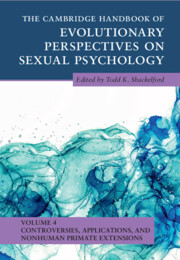Book contents
- The Cambridge Handbook of Evolutionary Perspectives on Sexual Psychology
- The Cambridge Handbook of Evolutionary Perspectives on Sexual Psychology
- Copyright page
- Contents
- Contributors
- Preface
- Part I Controversies and Unresolved Issues
- Part II Applications to Health, Law, and Pornography
- Part III Nonhuman Primate Sexual Behavior
- 14 Chimpanzee Sexual Behavior
- 15 Bonobo Sexual Behavior and Psychology
- 16 Orangutan Sexual Behavior
- 17 Gibbon Evolved Sexual Psychology
- 18 Sexual Behavior in Marmosets in the Context of Cooperative Breeding
- 19 Capuchin Sexual Behavior
- 20 Sexual Behavior in Neanderthals
- Index
- References
18 - Sexual Behavior in Marmosets in the Context of Cooperative Breeding
from Part III - Nonhuman Primate Sexual Behavior
Published online by Cambridge University Press: 30 June 2022
- The Cambridge Handbook of Evolutionary Perspectives on Sexual Psychology
- The Cambridge Handbook of Evolutionary Perspectives on Sexual Psychology
- Copyright page
- Contents
- Contributors
- Preface
- Part I Controversies and Unresolved Issues
- Part II Applications to Health, Law, and Pornography
- Part III Nonhuman Primate Sexual Behavior
- 14 Chimpanzee Sexual Behavior
- 15 Bonobo Sexual Behavior and Psychology
- 16 Orangutan Sexual Behavior
- 17 Gibbon Evolved Sexual Psychology
- 18 Sexual Behavior in Marmosets in the Context of Cooperative Breeding
- 19 Capuchin Sexual Behavior
- 20 Sexual Behavior in Neanderthals
- Index
- References
Summary
Sexual behavior in marmosets (Callithrix spp.) occurs within the context of cooperative breeding, a social system characterized by biparental and alloparental infant care, family-like social demography, and features of social monogamy. Both male and female reproductive strategies and sexual behavior are influenced by the social features of cooperative breeding. In this chapter, we first review the fundamentals of copulatory behavior in marmosets and its coordination by visual and olfactory cues. We then discuss the intricacies of the definition of “social monogamy” in primates and address the degree to which the concept is applicable to marmosets.In captivity, the only stable group demography is a monogamous pairing of a single adult male and female and their offspring. This demography is common in free-ranging groups of marmosets in eastern Brazil, but groups with multiple breeding males and/or females have been reported, suggesting flexibility in the mating system in marmosets. Reproductive strategies in marmosets are complex, and include inhibition of sexual behavior and physiology in subordinates, extrapair copulation and mating with individuals from neighboring groups especially during territorial encounters, extensive infant care by males and older offspring, and the formation of strong social attachments between breeding males and females. We conclude this chapter with a discussion of the proximate role of sex steroids in regulating features of marmoset sexual behavior, and propose that the neurohormone oxytocin plays a large role in orchestrating the social strategies that contribute to the unique features of marmoset sociosexual behavior.
- Type
- Chapter
- Information
- Publisher: Cambridge University PressPrint publication year: 2022
References
- 1
- Cited by



